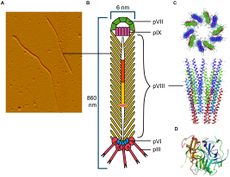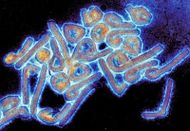CTXφ Bacteriophage: Difference between revisions
No edit summary |
No edit summary |
||
| Line 1: | Line 1: | ||
==Overview== | ==Overview== | ||
[[Image:Filamentous_phage.jpg|thumb|230px|right|<b>Figure 1:</b> Filamentous phage(s) under an electron microscope (left), an artist's rendition, and some computer-generated models of varying proteins found in the head, neck, and tail fibers.<ref name = Gagic>Gagic, D., Ciric M., Wen W., Ng F., Rakonjac J. (2016).</ref> From <i>Gagic D. et al.</i> <br> Link: https://www.frontiersin.org/articles/10.3389/fmicb.2016.00429/full]] | [[Image:Filamentous_phage.jpg|thumb|230px|right|<b>Figure 1:</b> Filamentous phage(s) under an electron microscope (left), an artist's rendition, and some computer-generated models of varying proteins found in the head, neck, and tail fibers.<ref name = Gagic>Gagic, D., Ciric M., Wen W., Ng F., Rakonjac J. (2016). "Exploring the Secretomes of Microbes and Microbial Communities Using Filamentous Phage Display." <i>Frontiers in Microbiology</i>, 7:429. https://doi.org/10.3389/fmicb.2016.00429.</ref> From <i>Gagic D. et al.</i> <br> Link: https://www.frontiersin.org/articles/10.3389/fmicb.2016.00429/full]] | ||
The CTXφ bacteriophage (or CTX<i>phi</i> bacteriophage) is a lysogenic, filamentous, single-stranded DNA phage that is responsible for turning the previously non-infectious <i>Vibrio cholerae</i> into a highly pathogenic microbe that causes disease in humans.<ref name = Davis>Davis, B. M., Kimsey, H. H., Chang, W., & Waldor, M. K. (1999). "The Vibrio cholerae O139 Calcutta bacteriophage CTXφ is infectious and encodes a novel repressor." <i>Journal of Bacteriology</i>, 181(21), 6779-6787.</ref>,<ref name = Ochman>Ochman, H., Lawrence, J. & Groisman, E. (2000). "Lateral gene transfer and the nature of bacterial innovation." <i>Nature</i>, 405, 299–304. https://doi.org/10.1038/35012500.</ref> | The CTXφ bacteriophage (or CTX<i>phi</i> bacteriophage) is a lysogenic, filamentous, single-stranded DNA phage that is responsible for turning the previously non-infectious <i>Vibrio cholerae</i> into a highly pathogenic microbe that causes disease in humans.<ref name = Davis>Davis, B. M., Kimsey, H. H., Chang, W., & Waldor, M. K. (1999). "The Vibrio cholerae O139 Calcutta bacteriophage CTXφ is infectious and encodes a novel repressor." <i>Journal of Bacteriology</i>, 181(21), 6779-6787.</ref>,<ref name = Ochman>Ochman, H., Lawrence, J. & Groisman, E. (2000). "Lateral gene transfer and the nature of bacterial innovation." <i>Nature</i>, 405, 299–304. https://doi.org/10.1038/35012500.</ref> | ||
<br><br> | <br><br> | ||
Revision as of 03:04, 11 December 2020
Overview

Link: https://www.frontiersin.org/articles/10.3389/fmicb.2016.00429/full
The CTXφ bacteriophage (or CTXphi bacteriophage) is a lysogenic, filamentous, single-stranded DNA phage that is responsible for turning the previously non-infectious Vibrio cholerae into a highly pathogenic microbe that causes disease in humans.[2],[3]
Genetic Material
Include some current research, with at least one image.
Infection, Replication & Lysing of Host Cell
At right is a sample image insertion. It works for any image uploaded anywhere to MicrobeWiki. The insertion code consists of:
Double brackets: [[
Filename: PHIL_1181_lores.jpg
Thumbnail status: |thumb|
Pixel size: |300px|
Placement on page: |right|
Legend/credit: Electron micrograph of the Ebola Zaire virus. This was the first photo ever taken of the virus, on 10/13/1976. By Dr. F.A. Murphy, now at U.C. Davis, then at the CDC.
Closed double brackets: ]]
Other examples:
Bold
Italic
Subscript: H2O
Superscript: Fe3+
CT & non-CT Toxins
Include some current research, with a second image.
Conclusion
Overall text length should be at least 1,000 words (before counting references), with at least 2 images. Include at least 5 references under Reference section.
References
- ↑ Gagic, D., Ciric M., Wen W., Ng F., Rakonjac J. (2016). "Exploring the Secretomes of Microbes and Microbial Communities Using Filamentous Phage Display." Frontiers in Microbiology, 7:429. https://doi.org/10.3389/fmicb.2016.00429.
- ↑ Davis, B. M., Kimsey, H. H., Chang, W., & Waldor, M. K. (1999). "The Vibrio cholerae O139 Calcutta bacteriophage CTXφ is infectious and encodes a novel repressor." Journal of Bacteriology, 181(21), 6779-6787.
- ↑ Ochman, H., Lawrence, J. & Groisman, E. (2000). "Lateral gene transfer and the nature of bacterial innovation." Nature, 405, 299–304. https://doi.org/10.1038/35012500.
Edited by Tara Cerny, student of Joan Slonczewski for BIOL 116 Information in Living Systems, 2019, Kenyon College.


